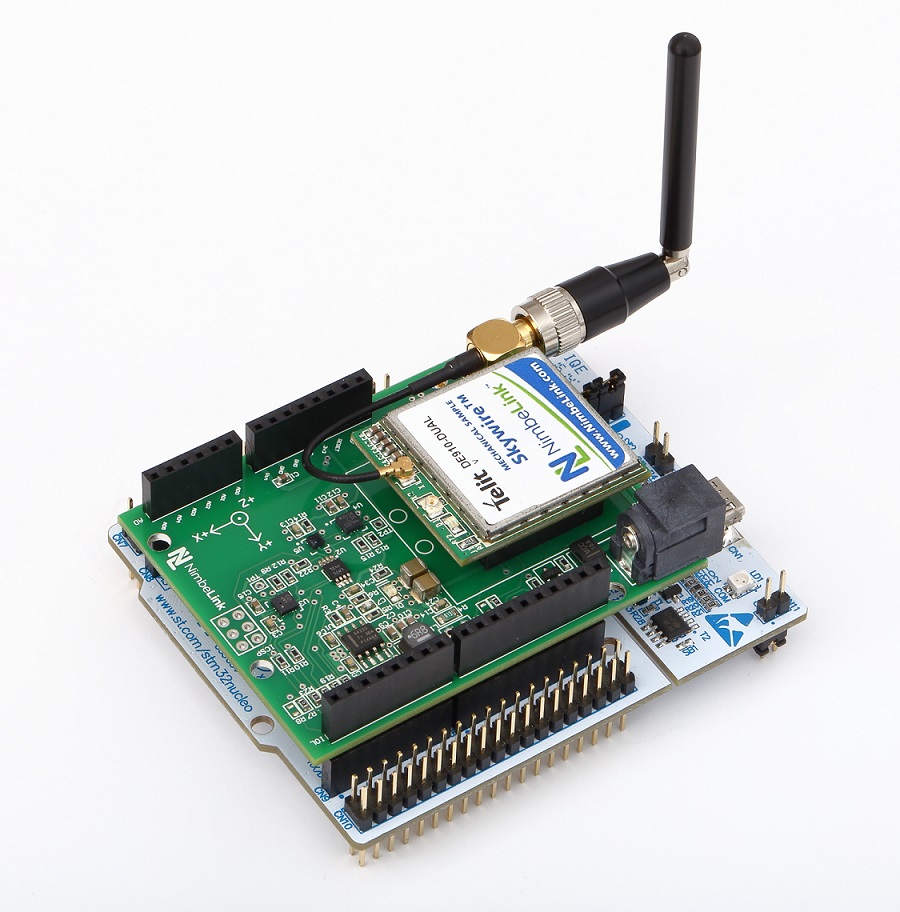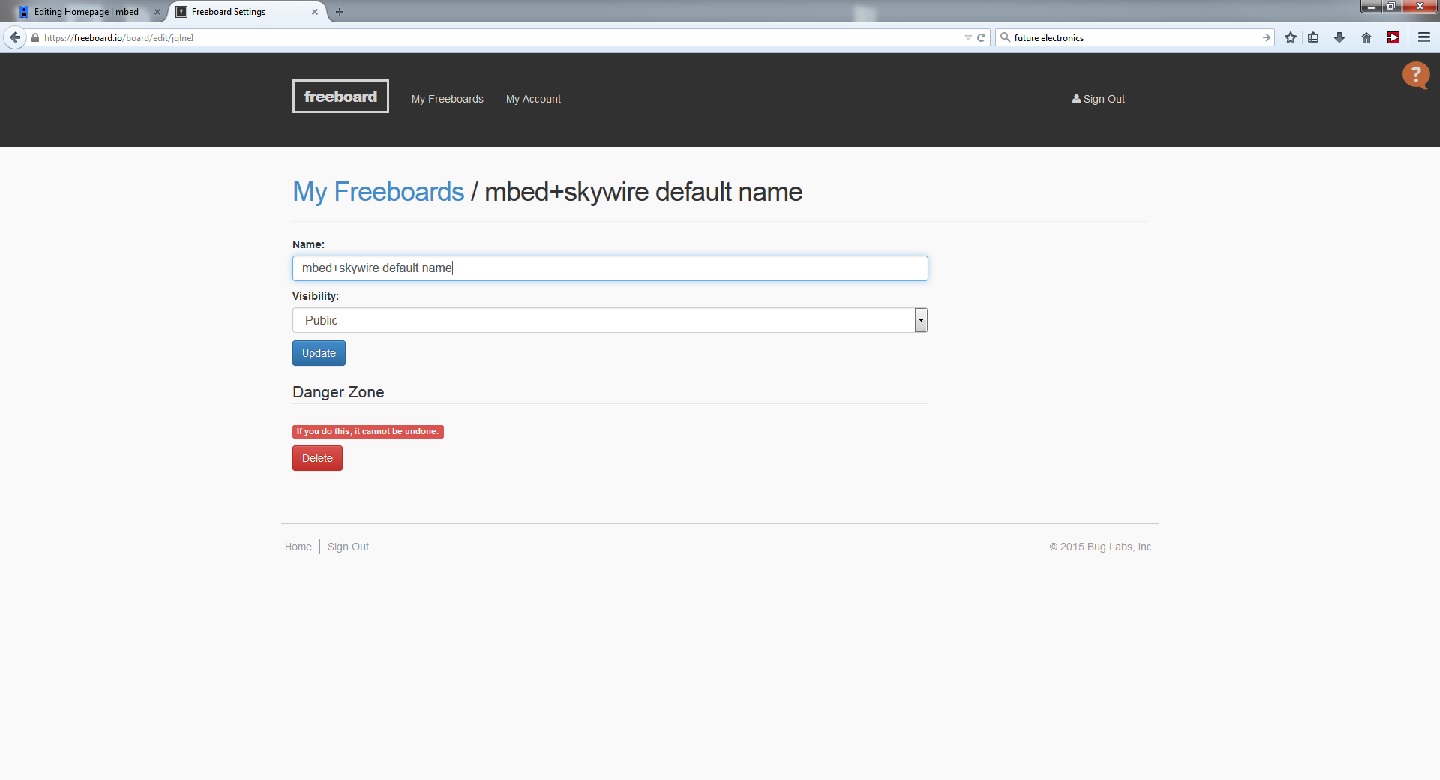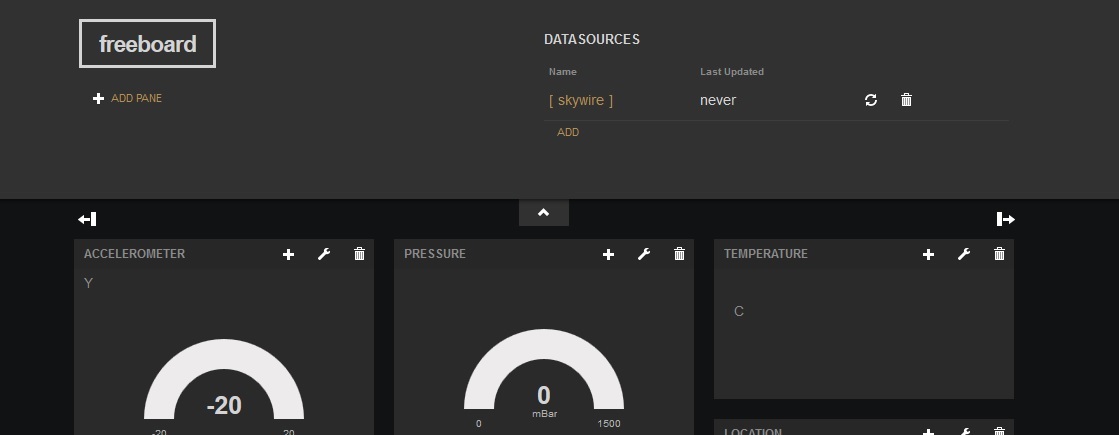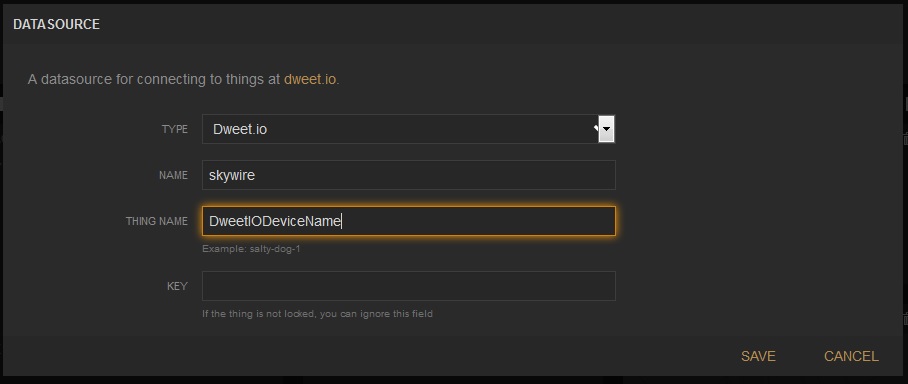Demo using a Nimbelink Skywire cellular modem paired with ST Nucleo. This demo reads several sensors and reports them to a Freeboard dashboard using dweet.io from Buglabs
Dependencies: LIS3DH LM75B LPS331 hts221 mbed
Fork of Skywire_Demo by
Getting Started Guide
- Set the JP5 jumper to E5V on the Nucleo
- Place the Skywire Shield onto the Nucleo as pictured
- Place the Skywire modem onto the Shield as picture and attach the antenna U.FL coax cable as pictured
- Plug the 12V wall supply into the Skywire Shield

- Go to https://freeboard.io/ and create a user account
- Once you are logged into your Freeboard account, go to https://freeboard.io/board/PJI272 and clone the dashboard by clicking the CLONE link in the lower right corner
- Old Revision of dashboard is here https://freeboard.io/board/jqlneI

- Old Revision of dashboard is here https://freeboard.io/board/jqlneI
- The new dashboard will show up on you account list under My Freeboards, you can then edit the name to whatever you like

- Under the Datasources tab on the dashboard, click the skywire link

- Change the THING NAME field to a unique string, we recommended using the MEID or IMEI on the Skywire Modem, but it could be anything you want.

- Next, Import the Skywire_Demo program into the online compiler
- Open main.cpp. Starting at Line 58, there is a list of Skywire Modems. Uncomment the Skywire Modem that you are using. Make sure only one Skywire Modem is uncommented:
main.cpp
/* * DEFINE THE SKYWIRE MODEM * Uncomment only the modem that you are using. * Make sure only one modem is uncommented! */ //#define NL_SW_1xRTT_V // Verizon 2G Modem - CE910-DUAL //#define NL_SW_1xRTT_S // Sprint 2G Modem - CE910-DUAL //#define NL_SW_1xRTT_A // Aeris 2G Modem - CE910-DUAL //#define NL_SW_GPRS // AT&T/T-Mobile 2G Modem //#define NL_SW_EVDO_V // Verizon 3G Modem //#define NL_SW_EVDO_A // Aeris 3G Modem //#define NL_SW_HSPAP // AT&T/T-Mobile 3G Modem //#define NL_SW_HSPAPG // AT&T/T-Mobile 3G Modem w/ GPS //#define NL_SW_HSPAPE // GSM 3G Modem, EU //#define NL_SW_LTE_TSVG // Verizon 4G LTE Modem //#define NL_SW_LTE_TNAG // AT&T/T-Mobile 4G LTE Modem //#define NL_SW_LTE_TEUG // GSM 4G LTE Modem, EU //#define NL_SW_LTE_GELS3 // VZW LTE Cat 1 Modem
- Next, to Line 73 in main.cpp, and change the DeviceID to the THING NAME you entered into your Freeboard:
main.cpp
/* --CHANGE THIS FOR YOUR SETUP" -- */ #define DeviceID "DweetIODeviceName" //Freeboard DweetIO unique ID
- If applicable, go to Line 77 in main.cpp and change the APN to your specific APN:
main.cpp
/* --CHANGE THIS FOR YORU SETUP (IF APPLICABLE)-- */
#if defined NL_SW_HSPAP || defined NL_SW_HSPAPG || defined NL_SW_HSPAPE || defined NL_SW_LTE_TSVG || defined NL_SW_LTE_TNAG || defined NL_SW_LTE_TEUG || defined NL_SW_LTE_GELS3
std::string APN = "yourAPNhere";
#endif
- Compile and upload to the Nucleo, cycle power to the shield and the sensor data should start to upload to your new Freeboard.
main.cpp
- Committer:
- kholland
- Date:
- 2016-03-29
- Revision:
- 10:5974a7b2cf38
- Parent:
- 9:555eb4259fc6
File content as of revision 10:5974a7b2cf38:
/* main.cpp */
/* v3.0
* Copyright (C) 2016 nimbelink.com, MIT License
*
* Permission is hereby granted, free of charge, to any person obtaining a copy of this software
* and associated documentation files (the "Software"), to deal in the Software without restriction,
* including without limitation the rights to use, copy, modify, merge, publish, distribute,
* sublicense, and/or sell copies of the Software, and to permit persons to whom the Software is
* furnished to do so, subject to the following conditions:
*
* The above copyright notice and this permission notice shall be included in all copies or
* substantial portions of the Software.
*
* THE SOFTWARE IS PROVIDED "AS IS", WITHOUT WARRANTY OF ANY KIND, EXPRESS OR IMPLIED, INCLUDING
* BUT NOT LIMITED TO THE WARRANTIES OF MERCHANTABILITY, FITNESS FOR A PARTICULAR PURPOSE AND
* NONINFRINGEMENT. IN NO EVENT SHALL THE AUTHORS OR COPYRIGHT HOLDERS BE LIABLE FOR ANY CLAIM,
* DAMAGES OR OTHER LIABILITY, WHETHER IN AN ACTION OF CONTRACT, TORT OR OTHERWISE, ARISING FROM,
* OUT OF OR IN CONNECTION WITH THE SOFTWARE OR THE USE OR OTHER DEALINGS IN THE SOFTWARE.
*/
/*
* DESCRIPTION
* This code updated sensor data on the Nimbelink ST Development Kit (NL-AB-ST-NCL) and sends
* the information to www.dweet.io using the Thingname "DeviceID". That information can be
* viewed using a Freeboard at www.freeboard.io (account required). Depending on your
* ST Development Kit version, clone the following freeboard:
* Rev A (Legacy): https://freeboard.io/board/jqlneI
* Rev B (Current): https://freeboard.io/board/LhnbrX
*
* Please consult the wiki for more information
*/
/*
* INSTRUCTIONS FOR USING THIS CODE
* 1. Under the "DEFINE THE SKYWIRE MODEM" section of the code, uncomment the modem that you
* are using to enable to proper setup and features of your Skywire modem.
*
* NOTE: Make sure the other Skywire modems listed are commented out.
*
* 2. Change the "DeviceID" to a unique identifier for your Nucleo board. One recommendation
* would be to use the MEID/IMEI of your Skywire Modem.
*
* 3. If applicable, change the APN for your Skywire Modem.
*/
#include "mbed.h"
#include "LPS331.h"
#include "LIS3DH.h"
#include "LM75B.h"
#include "hts221.h"
#include <string>
/*
* DEFINE THE SKYWIRE MODEM
* Uncomment only the modem that you are using.
* Make sure only one modem is uncommented!
*/
//#define NL_SW_1xRTT_V // Verizon 2G Modem - CE910-DUAL
//#define NL_SW_1xRTT_S // Sprint 2G Modem - CE910-DUAL
//#define NL_SW_1xRTT_A // Aeris 2G Modem - CE910-DUAL
//#define NL_SW_GPRS // AT&T/T-Mobile 2G Modem
//#define NL_SW_EVDO_V // Verizon 3G Modem
//#define NL_SW_EVDO_A // Aeris 3G Modem
//#define NL_SW_HSPAP // AT&T/T-Mobile 3G Modem
//#define NL_SW_HSPAPG // AT&T/T-Mobile 3G Modem w/ GPS
//#define NL_SW_HSPAPE // GSM 3G Modem, EU
//#define NL_SW_LTE_TSVG // Verizon 4G LTE Modem
//#define NL_SW_LTE_TNAG // AT&T/T-Mobile 4G LTE Modem
//#define NL_SW_LTE_TEUG // GSM 4G LTE Modem, EU
//#define NL_SW_LTE_GELS3 // VZW LTE Cat 1 Modem
/* --CHANGE THIS FOR YOUR SETUP-- */
#define DeviceID "yourDeviceIDhere" //Freeboard DweetIO unique ID
/* --CHANGE THIS FOR YORU SETUP (IF APPLICABLE)-- */
#if defined NL_SW_HSPAP || defined NL_SW_HSPAPG || defined NL_SW_HSPAPE || defined NL_SW_LTE_TSVG || defined NL_SW_LTE_TNAG || defined NL_SW_LTE_TEUG || defined NL_SW_LTE_GELS3
std::string APN = "yourAPNhere";
#endif
DigitalOut myled(LED1); // Main LED
DigitalOut skywire_en(PA_6); // Skywire Enable
DigitalOut skywire_rts(PA_7); // Skywire Send
DigitalOut green_LED(PA_1); // Green LED
DigitalOut red_LED(PA_4); // Red LED
DigitalOut blue_LED(PB_0); // Blue LED
AnalogIn photo_trans(PA_0); // Photo Transistor
AnalogIn pot(PC_0); // Potentiometer
DigitalIn button1(PB_3); // Button 1
DigitalIn button2(PC_1); // Button 2
Serial skywire(PA_9,PA_10); // Serial comms to Skywire
Serial debug_pc(USBTX, USBRX); // USB connection to PC
I2C i2c(PB_9,PB_8); // Setup I2C bus for sensors
bool sw1; // Boolean to check if button 1 is pressed
bool sw2; // Boolean to check if button 2 is pressed
LPS331 pressure(i2c); // Pressure Sensor
LM75B LM75_temp(PB_9,PB_8); // Temp Sensor
// Accelerometer
LIS3DH accel(i2c, LIS3DH_V_CHIP_ADDR, LIS3DH_DR_NR_LP_100HZ, LIS3DH_FS_2G);
HTS221 humidity(PB_9, PB_8); // Humidity Sensor
// char array for reading from Skywire
char str[255];
// Variables for GPS
float latitude;
float longitude;
int number;
// Variables for UART comms
volatile int rx_in=0;
volatile int rx_out=0;
const int buffer_size = 600;
char rx_buffer[buffer_size+1];
char rx_line[buffer_size];
// Interrupt for the Skywire
void Skywire_Rx_interrupt()
{
// Loop just in case more than one character is in UART's receive FIFO buffer
// Stop if buffer full
while ((skywire.readable()) && (((rx_in + 1) % buffer_size) != rx_out)) {
rx_buffer[rx_in] = skywire.getc();
rx_in = (rx_in + 1) % buffer_size;
}
return;
}
// Function to blink LEDs for debugging
// NOTE: Currently not used
void blink_leds(int num)
{
for (int i = 0; i < num; i++) {
blue_LED = 0;
wait(0.5);
blue_LED = 1;
wait(0.5);
}
}
// Read line from the UART
void read_line()
{
int i;
i = 0;
// Start Critical Section - don't interrupt while changing global buffer variables
__disable_irq();
// Loop reading rx buffer characters until end of line character
while ((i==0) || (rx_line[i-1] != '\n')) {
// Wait if buffer empty
if (rx_in == rx_out) {
// End Critical Section - need to allow rx interrupt to get new characters for buffer
__enable_irq();
while (rx_in == rx_out) {
}
// Start Critical Section - don't interrupt while changing global buffer variables
__disable_irq();
}
rx_line[i] = rx_buffer[rx_out];
i++;
rx_out = (rx_out + 1) % buffer_size;
}
// End Critical Section
__enable_irq();
rx_line[i-1] = 0;
return;
}
// Wait for specific response
int WaitForResponse(char* response, int num)
{
do {
read_line();
debug_pc.printf("Waiting for: %s, Recieved: %s\r\n", response, rx_line);
} while (strncmp(rx_line, response, num));
return 0;
}
int main()
{
float axis[3];
float press;
float temp;
float humi;
float dummy_temp;
// Setup serial comms with Skywire and PC
debug_pc.baud(115200);
skywire.baud(115200);
debug_pc.printf("SystemCoreClock = %d Hz\r\n", SystemCoreClock);
skywire.attach(&Skywire_Rx_interrupt, Serial::RxIrq);
// Turn on blue LED
green_LED = 0;
red_LED = 0;
blue_LED = 1;
skywire_rts=0;
myled=0;
debug_pc.printf("Starting Demo...\r\n");
debug_pc.printf("Waiting for Skywire to Boot...\r\n");
//Enable Skywire
skywire_en=0;
wait(2);
skywire_en=1;
wait(2);
skywire_en=0;
myled=1;
// Wait for modem to initialize
// Wait time is different for each modem
#if defined NL_SW_LTE_GELS3
wait(60);
#elif defined NL_SW_LTE_TSVG || defined NL_SW_LTE_TNAG || defined NL_SW_LTE_TEUG
wait(15);
#else
wait(5);
#endif
// Start temp reading
LM75_temp.open();
//Turn off echo
// Helps with checking responses from Skywire
debug_pc.printf("Turning off echo...\r\n");
skywire.printf("ATE0\r\n");
WaitForResponse("OK", 2);
// Turn on DNS Response Caching
// Used on the Telit-based Skywires
#if !defined NL_SW_LTE_GELS3
debug_pc.printf("Turning on DNS Cacheing to improve speed...");
skywire.printf("AT#CACHEDNS=1\r\n");
WaitForResponse("OK", 2);
#endif
debug_pc.printf("Connecting to Network...\r\n");
// get IP address
#if defined NL_SW_LTE_GELS3
// The last parameter in AT+SQNSCFG sets the timeout if transmit buffer is not full
// Time is in hundreds of ms: so, a value of 5 = 500ms
debug_pc.printf("Configuring context part 1...\r\n");
skywire.printf("AT+SQNSCFG=3,3,300,90,600,5\r\n");
WaitForResponse("OK", 2);
wait(1);
debug_pc.printf("Configuring context part 2...\r\n");
skywire.printf("AT+CGDCONT=3,\"IP\",\"vzwinternet\"\r\n");
WaitForResponse("OK", 2);
wait(1);
debug_pc.printf("Activating context...\r\n");
skywire.printf("AT+CGACT=1,3\r\n");
#elif defined NL_SW_LTE_TSVG
// The last parameter in AT#SCFG sets the timeout if transmit buffer is not full
// Time is in hundreds of ms: so, a value of 5 = 500 ms
skywire.printf("AT#SCFG=3,3,300,90,600,5\r\n");
WaitForResponse("OK", 2);
wait(1);
skywire.printf("AT+CGDCONT=3,\"IP\",\"%s\"\r\n", APN);
WaitForResponse("OK", 2);
wait(1);
skywire.printf("AT#SGACT=3,1\r\n");
WaitForResponse("#SGACT", 6);
#else
// The last parameter in AT#SCFG sets the timeout if transmit buffer is not full
// Time is in hundreds of ms: so, a value of 5 = 500 ms
skywire.printf("AT#SCFG=1,1,300,90,600,5\r\n");
WaitForResponse("OK", 2);
skywire.printf("AT#SGACT=1,1\r\n");
WaitForResponse("#SGACT", 6);
#endif
WaitForResponse("OK", 2);
// Get triangulation data
// NOTE: This only works on the below modems!
#if defined NL_SW_1xRTT_V || defined NL_SW_1xRTT_S || defined NL_SW_1xRTT_A || defined NL_SW_GPRS || defined NL_SW_EVDO_V || defined NL_SW_EVDO_A || defined NL_SW_HSPAP || defined NL_SW_HSPAPG || defined NL_SW_HSPAPE
//get location approximation from cell tower information
skywire.printf("AT#AGPSSND\r\n");
WaitForResponse("#AGPSRING:", 10);
sscanf(rx_line, "%s %d,%f,%f,", str, &number, &latitude, &longitude);
debug_pc.printf("Location: Latt:%f, Long:%f\r\n", latitude, longitude);
#endif
red_LED = 0;
blue_LED = 0;
green_LED = 1;
while(1) {
// Green on to indicate code position
// Start of loop. Either entered loop for the first time or just sent to dweet.io
red_LED = 0;
blue_LED = 0;
green_LED = 1;
// connect to dweet.io
#if defined NL_SW_LTE_GELS3
skywire.printf("AT+SQNSD=3,0,80,\"dweet.io\"\r\n");
#elif defined NL_SW_LTE_TSVG
skywire.printf("AT#SD=3,0,80,\"dweet.io\"\r\n");
#else
skywire.printf("AT#SD=1,0,80,\"dweet.io\"\r\n");
#endif
WaitForResponse("CONNECT", 7);
// Update the sensors
temp = (float)LM75_temp;
//temp = (temp * 9)/5 + 32; // convert C to F
debug_pc.printf("Temp = %.3f\r\n", temp);
press=(float)pressure.value() / 4096;
debug_pc.printf("Pressure = %.3f\r\n", press);
humidity.ReadTempHumi(&dummy_temp, &humi);
debug_pc.printf("Humidity = %.3f\r\n", humi);
accel.read_data(axis);
debug_pc.printf("Accel = %.3f, %.3f, %.3f\r\n", axis[0], axis[1], axis[2]);
wait(1);
// Check buttons for presses
if (button1 == 0)
sw1 = 0;
else
sw1 = 1;
if (button2 == 0)
sw2 = 0;
else
sw2 = 1;
// Green on to indicate code position:
// Sensors updated, have not sent to dweet.io
red_LED = 1;
green_LED = 0;
blue_LED = 0;
debug_pc.printf("Sending information...\r\n");
// Report the sensor data to dweet.io
skywire.printf("POST /dweet/for/%s?temp=%.3f&p=%.3f&X=%.3f&Y=%.3f&Z=%.3f&La=%f&Lo=%f&sw1=%d&sw2=%d&pot=%.3f&photo=%.3f&humidity=%.3f HTTP/1.0\r\n\r\n", DeviceID, temp, press, axis[0], axis[1], axis[2], latitude, longitude, sw1, sw2, (pot * 3), (photo_trans * 100), humi);
// Blue on to indicate code position
// Data sent to dweet
red_LED = 0;
green_LED = 0;
blue_LED = 1;
// Wait for response from dweet.io
#if defined NL_SW_LTE_GELS3
WaitForResponse("OK", 2);
wait(1);
#else
WaitForResponse("NO CARRIER", 10);
#endif
}
}

 SkywireTM Cellular mbed Shield
SkywireTM Cellular mbed Shield